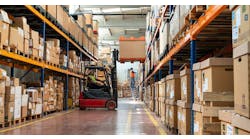Wirtz Beverage is an Illinois-based wine and spirits distributor with operations in Iowa, Minnesota, Missouri, Nevada and Wisconsin. In the 1990s, the company expanded operations throughout Illinois, and in 2003, began adding warehouses to support its operations. Most recently, in 2008, when the company combined operations in Illinois with Glazer's Distributors, the company went from shipping four million to eight million cases a year. It also ended up operating out of three metro warehouse facilities in Chicago, plus an additional office building, and rebranding under the Wirtz Beverage name.
The company went from handling 50,000 to 84,000 cases a night using a shipping sorter designed for 5,300 cases per hour. But it was still taking too long for Wirtz to get its trucks on the road to service its customers. Such business growth required automation.
Each of the warehouse facilities in Chicago served a special purpose in a just-in-time order fulfillment process managed by Wirtz Beverage's warehouse management system (WMS). One facility, with pick modules and a conveyor and shipping sorter system, was used to consolidate orders and load trucks. The second was used for bulk storage, while the third served to consolidate slow-moving SKUs.
Pick modules in the order fulfillment warehouse were replenished with cartons from the bulk storage facility. In addition, slow-moving SKUs were pulled from the two satellite facilities and delivered to that facility. Those cartons were manually inducted onto the conveyor and sorter system and married with the items being picked in the facility.
Three Warehouses in One
The company realized it had to consolidate its operations under one roof if it was going to continue to grow, so it started with a clean sheet of paper and designed an automated system that would accurately build their loads in the most efficient way while still being cost justifiable. They needed to be able to meet seasonal spikes, too, while optimizing the available space.
Wirtz then looked for buildings up to 100 feet high and decided on a maximum distance of 45feet to the roof, which would be the most cost-effective and versatile.
It worked with a systems integrator (W&H Systems, www.whsystems.com) to consolidate operations from three facilities into one new 555,500-square-foot distribution center near Midway Airport in Cicero.
"We were familiar with W&H's Paul Laman and his expertise in the wine and spirits distribution industry," said Rocky Ruane, Wirtz's regional director of warehouse operations. "We were comfortable his company knew what it was doing."
While the new facility appears to be a showcase for material handling technology, Wirtz did not automate for the sake of automation. Rather, the distributor took a balanced approach to the design of the facility based on three certainties:
• It was still going to floor-load trailers based on the order profile;
• It would use the same type of delivery equipment; and
• It would have very few pallet deliveries.
Knowing those things, Wirtz wanted to design a system that would accurately build loads in the most efficient way.
Vertical AS/RS
The new building now incorporates a vertical automated storage and retrieval system (AS/RS) (Westfalia, www.westfaliausa.com) that stores pallets five high for a total of 1.3 million cases with the ability to expand up to 3 million cases. To streamline the receiving and putaway processes, the AS/RS was erected close to the receiving dock. It was also designed to handle both storage and replenishment duties to get more out of the system. Along with putting pallets away into storage, pallets are placed on flow lanes in each pick face.
Although the new AS/RS was a sizeable investment, the labor freed up by automating the replenishment activities was a key factor in delivering an ROI. The overall building was 150,000 sq. ft. smaller than it would have been with a conventional system and storage.
There is also significant labor savings for inventory put-away and pick module replenishment, as well as a reduction in breakage due to less product impact and operator error.
Voice-directed picking was another new technology introduced in the Cicero facility. Previously, the company used pick-to-light in its split case, bottle-pick areas in its order fulfillment facility. Using voice, associates can pick >600 bottles per hour. The last improvement was a merge and combiner in the shipping sorter that significantly improved the flow of cases through the facility. It increased the after-sort buffer from 80 to 90 cases per truck to 425 cases per truck.
Integrated Software
Tying together storage, conveyor and picking technologies required the integration of four different software systems. The software scheme begins with an enterprise resource planning (ERP) system that manages processes at the highest level. Incoming product is received into the facility and scanned into the warehouse management system. The WMS also directs put-away processes into the conventional storage areas. Pallets that will be stored in the AS/RS are scanned and measured when they are inducted into the system by conveyor.
At that point, management of the pallet is transferred to the warehouse control system (WCS) in charge of the AS/RS. That system directs the cranes to put pallets into storage locations and directs replenishment of the picking areas.
A third software system creates wave picking plans that are shared with other systems. The WMS directs all of the picking operations.
Finally, a WCS manages the conveyors, coordinates the delivery of cartons to the shipping sorter, and puts them in the right sequence for loading into trucks.
Intoxicating Results
Within four months of going live in the new facility, Wirtz Beverage could process 85,000 cases in 10 hours, and the system had room to grow. The AS/RS alone can be expanded to store more than 2.2 million cases. That was important to this family-owned business since it is planning for the next generation, not just the next quarter.
But as for today, this distributor is filling all of its orders and getting its trucks on the road in time to be a stronger competitor in the adult beverage industry.
"The move to automate was driven by business growth," concludes Art Wirtz, executive vice president of supply chain and grandson of the founder. "It has significantly improved our operations."





